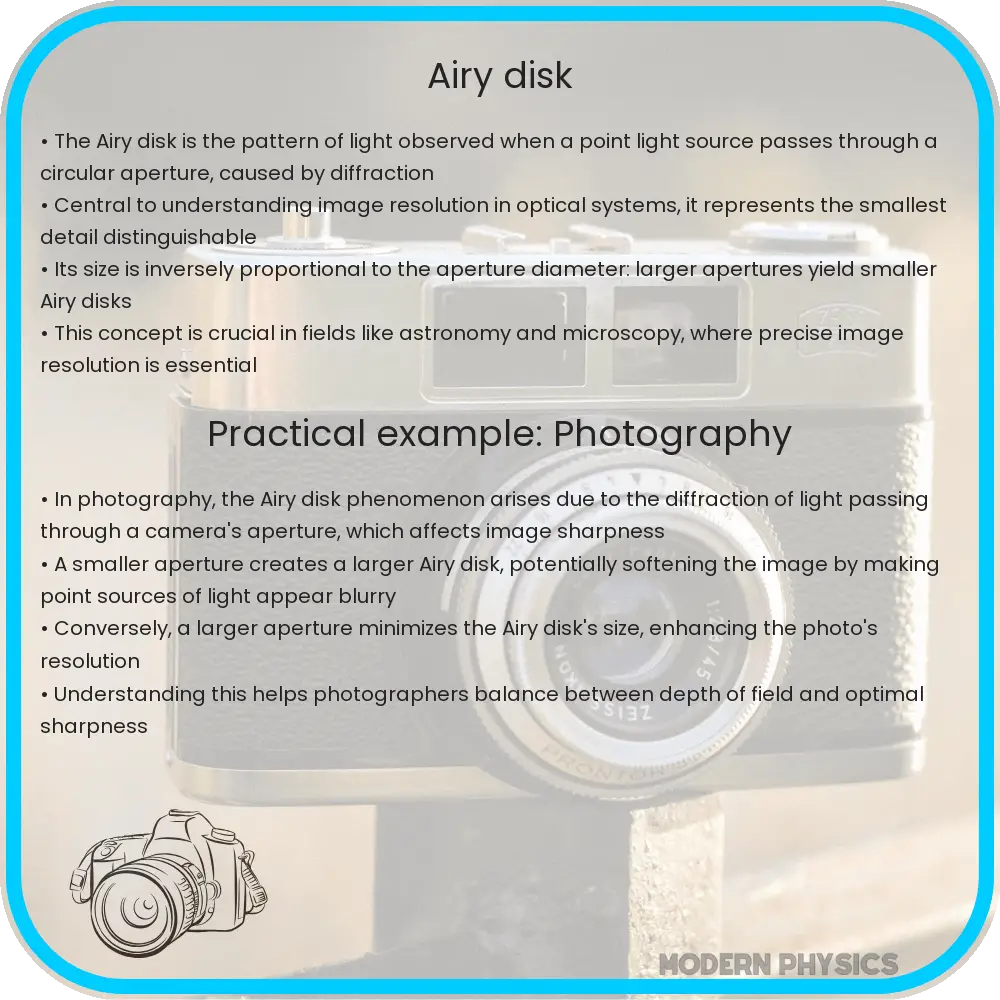Learn about the Airy disk, a key diffraction pattern formed when light passes through a circular aperture, crucial for understanding optical system resolution.

Understanding the Airy Disk: A Key Concept in Optical Physics
When a wave of light passes through a small aperture, such as the pupil of your eye or the lens of a camera, it doesn’t simply pass through unaffected. Instead, it undergoes a phenomenon known as diffraction, which significantly influences the behavior of light. One of the most interesting outcomes of diffraction is the formation of an Airy disk, named after the British astronomer Sir George Biddell Airy, who first explained it in 1835.
What is an Airy Disk?
An Airy disk is a pattern of light that typically appears as a bright central spot surrounded by rings of light and dark bands. This pattern is the result of the wave nature of light; when light waves pass through a circular aperture, they interfere with each other constructively and destructively, forming a diffraction pattern. The central bright spot, the Airy disk, is where the light waves are most constructively interfered, and it’s flanked by darker and brighter rings due to alternating destructive and constructive interference.
Mathematical Description of Airy Disk Formation
The intensity of light in an Airy pattern can be described mathematically using the Bessel function of the first kind, denoted as J1. The intensity I(r) as a function of radial distance r from the center of the diffraction pattern is given by:
\[ I(r) = I_0 \left( \frac{2 \cdot J_1(\frac{r \cdot \pi \cdot D}{\lambda \cdot f})}{\frac{r \cdot \pi \cdot D}{\lambda \cdot f}} \right)^2 \]
where:
- I0 is the peak intensity at the center of the Airy disk.
- D is the diameter of the aperture through which the light is passing.
- \(\lambda\) is the wavelength of the incident light.
- f is the focal length of the lens.
Diffraction Limit and Resolution
The diffraction pattern imposed by the Airy disk plays a critical role in determining the resolution of an imaging system, whether it’s a microscope, a telescope, or a camera. The resolution of such optical systems is limited by the size of the Airy disk. Essentially, the smaller the Airy disk, the higher the potential resolution of the image.
The size of the Airy disk is primarily determined by the wavelength of light (\(\lambda\)) and the diameter of the aperture (D). According to Rayleigh’s criterion, two point light sources are considered to be resolved if the principal maximum of the diffraction pattern of one is coincident with the first minimum of the other.
The angular resolution \(\theta\) can be approximated by:
\[ \theta \approx 1.22 \cdot \frac{\lambda}{D} \]
where \(\theta\) is the smallest angular separation at which two details can be distinguished. This relationship shows that increasing the diameter of the aperture or using light of shorter wavelength can enhance the resolution of an imaging system.
Applications in Modern Technology
The concept of the Airy disk is not only fundamental in theoretical physics but also immensely practical in various technological fields. In photography, understanding the diffraction limit helps in designing lenses that minimize the effect of diffraction, allowing for sharper images. Similarly, in astronomy, telescopes are designed based on the size of the Airy disk to maximize the resolution of celestial images.
In the realm of microscopy, the Airy disk determines the limit of resolution obtainable. Advanced techniques, such as adjusting the wavelength of the light source or increasing the numerical aperture of the microscope, are employed to reduce the size of the Airy disk, thereby enhancing the microscope’s resolving power.
Limitations and Beyond
While the Airy disk sets a fundamental limit to resolution, modern science and engineering continuously push these boundaries. Techniques like super-resolution microscopy and adaptive optics are examples where the traditional limits imposed by diffraction are overcome. Super-resolution microscopy, for example, uses fluorescent molecules and special imaging techniques to observe structures smaller than the diffraction limit.
Adaptive optics, used in telescopes, adjusts the incoming light wavefront disturbed by the Earth’s atmosphere to reduce the impact of diffraction and improve image clarity. These advancements demonstrate that while the principles of diffraction are limiting, they are not insurmountable in the pursuit of greater knowledge and clearer images.
Conclusion
The Airy disk is a fascinating phenomenon that stems from the fundamental wave nature of light. Through its study, not only can we appreciate the inherent beauty of physics, but we also gain profound insights into the limits and capabilities of optical devices. As technology progresses, the understanding of phenomena like the Airy disk becomes crucial in pushing the boundaries of what is visually resolvable.
Whether in improving the high-resolution capabilities of microscopes, enhancing the quality of photographs, or advancing astronomical observations, the principles surrounding the Airy disk influence many aspects of both science and everyday technology. By continuing to explore this fundamental concept, scientists and engineers can develop new techniques to transcend traditional limits, paving the way for innovations that were once thought impossible.
